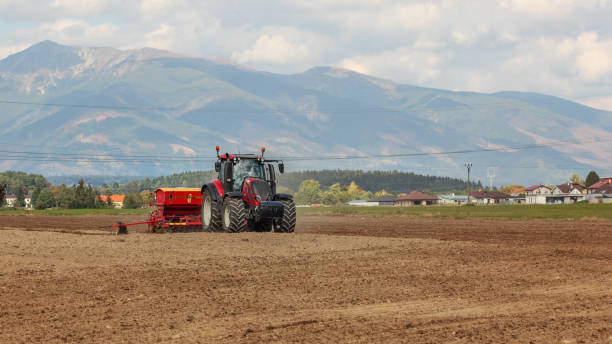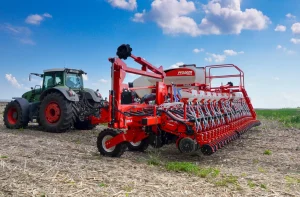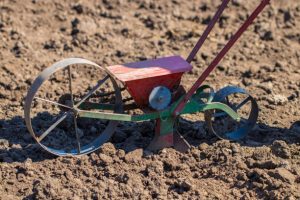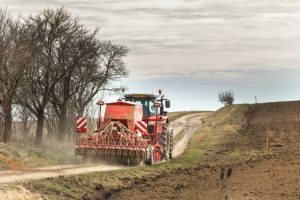The traditional image of agriculture often involves vast fields plowed under, a canvas prepared for seed scattering. But beneath the surface, a silent revolution is brewing – no-till farming. This innovative approach prioritizes soil health and sustainability, and at its heart lies a crucial tool: the seed drill.
So, how do seed drills unlock the magic of no-till farming? Let’s delve into the many benefits they offer:
1. Minimizing Soil Disruption: Traditional plowing disturbs the delicate balance of soil life, exposing beneficial microbes and releasing carbon dioxide. No-till drills, however, plant seeds directly into the undisturbed soil, preserving its structure and promoting the growth of a healthy microbiome. This leads to improved water retention, increased nutrient cycling, and enhanced soil fertility.
2. Reduced Erosion: Plowed fields are vulnerable to erosion, especially during heavy rains. By leaving plant residues on the surface, no-till farming creates a protective layer that shields the soil from erosion. Seed drills then navigate through this cover, further minimizing soil disturbance and safeguarding against erosion.
3. Precision Placement: Modern seed drills boast advanced technology like GPS guidance and variable rate seeding. This allows for optimal seed placement, ensuring each seed lands at the desired depth and spacing for maximum germination and growth. This precision minimizes seed waste and optimizes resource usage, making no-till farming even more efficient.
4. Improved Moisture Retention: Undisturbed soil acts like a sponge, holding onto moisture more effectively than tilled land. This is particularly beneficial in arid regions, where water scarcity is a major challenge. Seed drills further contribute to moisture retention by disturbing the soil minimally, leaving the protective cover layer intact.
5. Lower Fuel Costs: Plowing requires significant fuel input, contributing to both environmental and operational costs. No-till farming, with its minimal soil disturbance, eliminates the need for plowing, leading to substantial fuel savings for farmers. This translates to decreased operational expenses and a smaller carbon footprint.
6. Increased Carbon Sequestration: Healthy soil acts as a carbon sink, storing atmospheric carbon dioxide and mitigating climate change. No-till farming promotes carbon sequestration by preserving soil structure and encouraging the growth of beneficial microbes. Seed drills, by minimizing soil disturbance, further contribute to this vital process.
7. Enhanced Biodiversity: The undisturbed soil environment created by no-till farming promotes a diverse range of soil organisms, including earthworms and fungi. This biodiversity plays a crucial role in nutrient cycling, pest control, and overall soil health, leading to a more resilient and productive agricultural ecosystem.
8. Weed Suppression: The cover crop residue left on the surface of no-till fields acts as a natural weed suppressor. This reduces the need for herbicides, minimizing environmental impact and improving soil health. Seed drills, by precisely placing seeds through the cover crop, ensure effective planting while maintaining weed control.
9. Improved Farm Profits: The combined benefits of improved soil health, increased yields, reduced input costs, and lower environmental impact can lead to significant economic advantages for no-till farmers. With optimized resource use and increased productivity, no-till farming paves the way for a more sustainable and profitable future for agriculture.
10. A Legacy of Conservation: No-till farming is not just a technological advancement; it’s a shift towards a more conscious and responsible approach to agriculture. By prioritizing soil health and environmental sustainability, no-till farming leaves a lasting legacy for future generations, ensuring a vibrant and fertile land for years to come.
Seed drills, therefore, are not just planting tools in the no-till revolution; they are its silent champions. By ensuring precise seed placement and minimizing soil disturbance, they empower farmers to unlock the full potential of this sustainable approach, paving the way for a future where healthy soils and bountiful harvests go hand in hand.
Embracing no-till farming with the aid of advanced seed drills is not just a technological leap; it’s a pledge to the land, a commitment to environmental stewardship, and a promise of a thriving future for generations to come. Each precisely placed seed becomes a testament to the enduring power of innovation, a living symbol of how we can nurture the earth and reap its bounty in a sustainable and responsible way.
So, let us celebrate the quiet heroes of the field – the seed drills – for they are more than just mechanical instruments. They are catalysts for change, agents of conservation, and seeds of hope sown into the fertile ground of a resilient future. And as we witness the fields flourish under their gentle guidance, let us be inspired to cultivate not just crops, but a legacy of environmental responsibility and agricultural prosperity for all.




